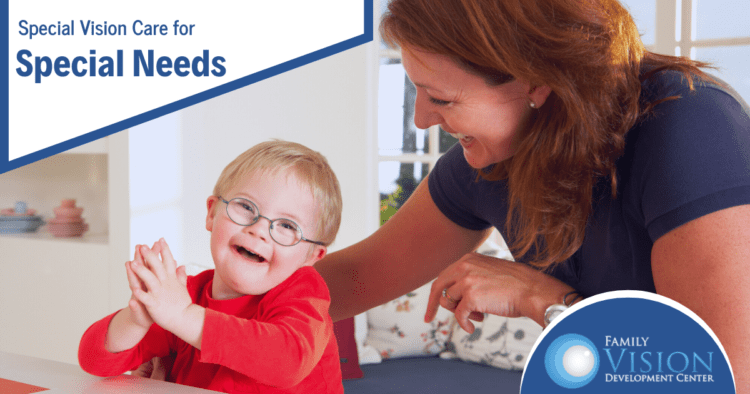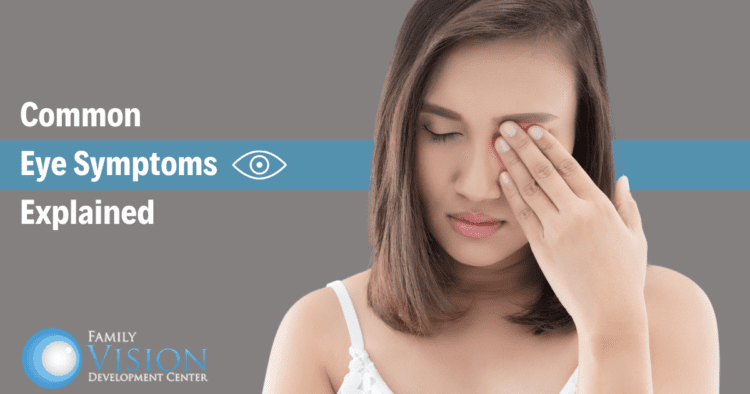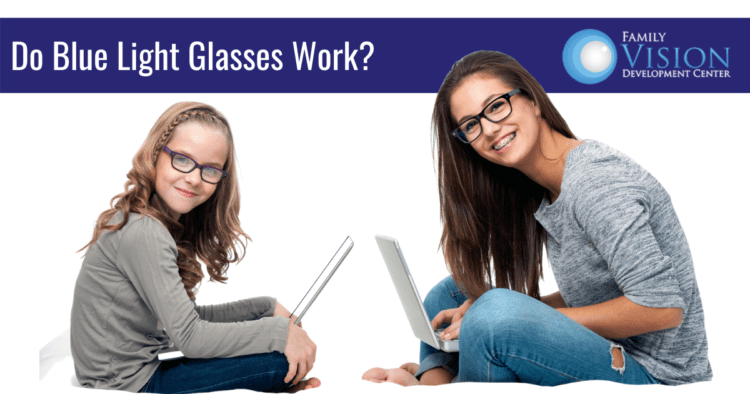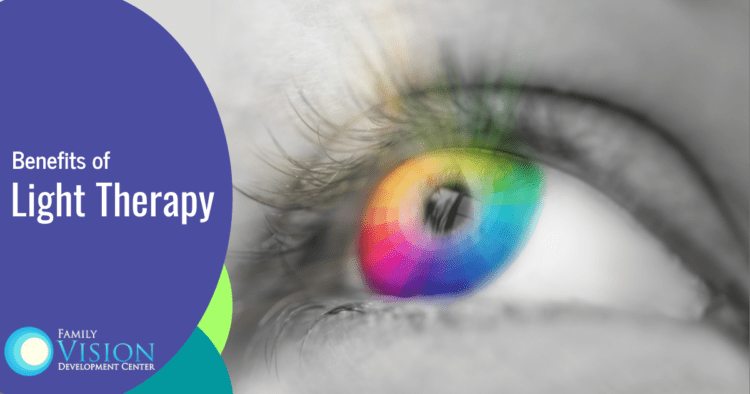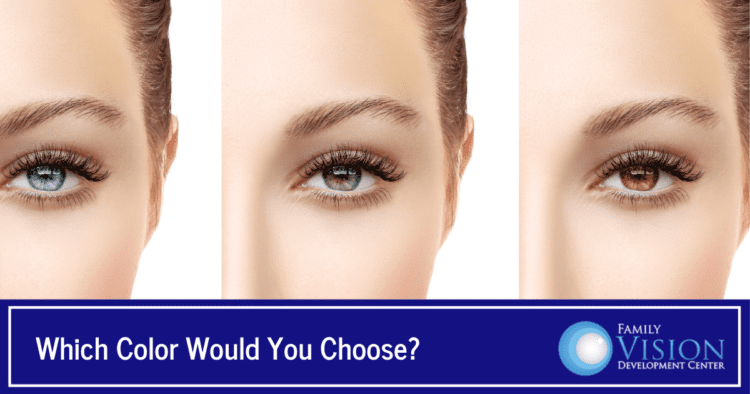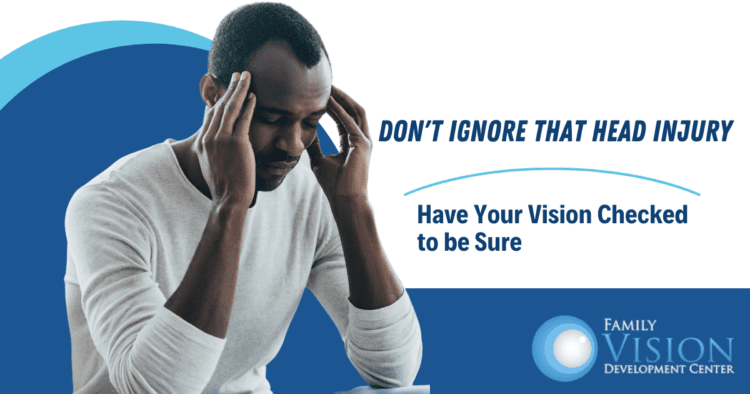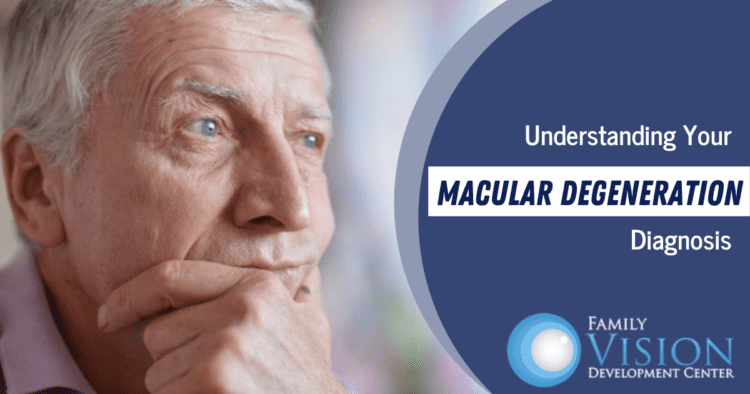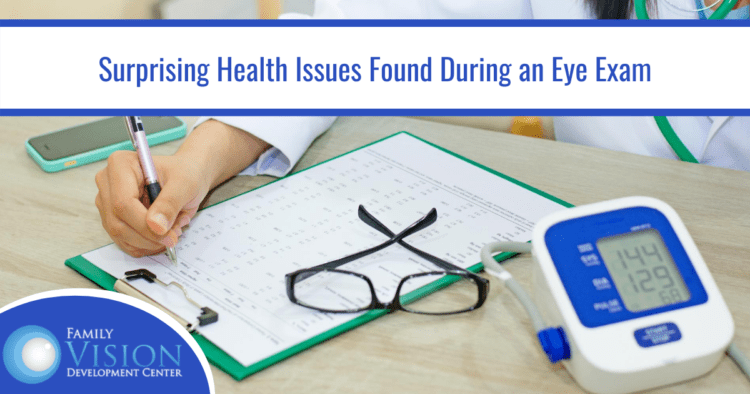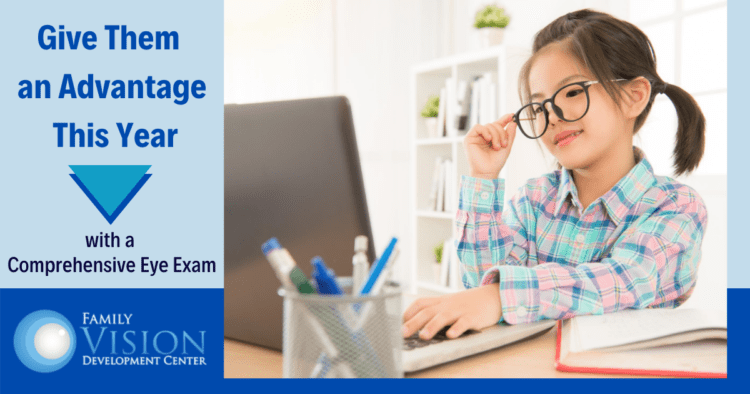Children with special needs such as Down Syndrome, Fragile X Syndrome, autism spectrum disorders, premature birth or other genetic disorders are often faced with many challenges throughout life. One of those challenges that can affect them on a daily basis is the risk of developing a vision disorder.
While the vision disorders that affect kids with special needs can be the same as those of neurotypical kids, they tend to experience them at a higher rate. For this reason, it’s important to keep up on regular eye exams in order to detect the following types of issues.
- Focusing issues – the inability to focus on objects that are either close up or far away
- Tracking issues – eye movements may be slow, inaccurate or jump around
- Poor visual attention – the inability to filter out non-essential visual information when viewing the world
- Poor eye teaming and coordination – problems with both eyes working together in a coordinated way
- Poor hand-eye coordination – difficulty completing a physical task based on the visual information received by the eyes
Watch for These Signs
Even if your child is not able to clearly articulate a vision issue, there are certain signs that you can look for that could indicate a problem:
- Skips or repeats words or lines when reading
- Closes one eye when reading
- Poor reading comprehension
- Trouble concentrating when reading
- Holds books very close when reading
- Messy handwriting
- Unusual neck or body posture
- Trips frequently or knocks things over
- Experiences motion sickness
- One or both eyes turn inward or outward
Vision Therapy for Special Needs
The specially trained optometrists at Family Vision Development Center provide individualized, one-on-one vision therapy programs that can be an extremely effective form of treatment for kids with a vision disorder. Once we have clearly identified the visual issue, this vision therapy serves as a kind of re-training of the eyes and brain to develop or restore proper visual function.
At Family Vision Development Center, we understand the importance of providing the best possible care for kids with special needs. And our caring providers always strive to help every child overcome their challenges and achieve the most healthy vision possible. Contact our Aurora office at 630-862-2020 to learn more or to schedule your appointment.
Additional information can be referenced here
Have you ever been sitting quietly, perhaps watching television, and out of nowhere your eye starts twitching? It may seem to be completely random, but there are many possible reasons for this strange occurrence. In fact, people often experience eye symptoms that are questionable. What do they mean? Do you need to seek treatment? Here are a few common eye symptoms and what may be causing them.
Crust
One of the more common eye symptoms is waking up with some crust, or “sleep”, in your eyes, and is perfectly normal as it is simply residue from the eye’s natural protective process. However, while finding crust-like residue in the corners of your eye or on your lashes is fine when waking after sleeping, crusty eyes during waking hours could be caused by a condition known as blepharitis, or inflammation of the eyelids, which you should get medical attention for. In fact, any eye discharge that is more than simple flakes after sleeping could be an indicator of a greater issue, such as dry eye or pink eye (conjunctivitis).
Red eyes
Red eyes are another one of those eye symptoms that is usually harmless, but not in every case. Red eyes occur when the tiny blood vessels on the whites of your eyes expand, making them appear red. In most instances, it is caused by a relatively harmless factor like fatigue, allergies, smoke, chlorine or wearing your contacts too long. However, red eyes that last more than a day or two could indicate a more serious problem such as an eye infection, a corneal ulcer or glaucoma.
Eye twitching
Almost every person experiences some form of eyelid twitching in his or her lifetime. Known medically as myokymia, these involuntary spasms of the eyelid muscles can occur every few seconds over the course of several minutes. Typically, eyelid twitching is a harmless annoyance brought on by stress, lack of sleep, caffeine, tobacco use or even exercise. But in some cases, it can result from a more serious issue. An eye twitch that doesn’t go away relatively quickly can be a sign of a brain or nerve disorder such as Bell’s Palsy, Parkinson’s Disease, Tourette Syndrome or Multiple Sclerosis.
Blurred vision
Some eye symptoms, like blurred vision, could indicate a serious issue and should be discussed with your eye doctor. Blurred vision can indicate myopia (distant objects are blurry), hyperopia (difficulty focusing on close objects), astigmatism (blurred vision at all distances) or presbyopia (normal age-related vision problem). Each of these conditions can be treated relatively easily with corrective eyeglasses or contact lenses. However, there are more serious conditions that might be present if you are experiencing blurred vision. These could include cataracts, glaucoma, age-related macular degeneration, diabetic retinopathy or cardiovascular disease.
Yellow eyes
A yellow appearance in your eye can be harmless, or serious, so it is important to see your eye doctor for an accurate diagnosis. For example, yellow spots on your eyes can simply be protein, fat or calcium growths that are not a cause for concern unless they are interfering with your vision. In contrast, if the whites of your eyes are instead yellow, that can be a sign of jaundice which could be caused by hepatitis, gallstones or even liver cancer.
You can never be too careful when it comes to taking care of your vision. Even a simple issue could be a sign of a more serious problem if it doesn’t clear up quickly. So it’s important to trust your gut when it comes to any kind of problem that you are experiencing with your eyes.
At Family Vision Development Center we offer full service eye care. This means we can provide all of the vision needs for your whole family. This includes general eye exams, advanced vision therapy services, contact lens fittings and the ability to diagnose and treat ocular disease such as glaucoma, cataracts, macular degeneration, dry eye and diabetes just to name a few. Contact our office at 630-862-2020 for information or to schedule your appointment.
Additional information can be referenced here and here.
When driving a car, the ability to see the road and surroundings clearly is essential to the safety of everyone in the vehicle. Reflective glare while driving can be a big problem in a number of situations.
For example, the light reflecting off of snow in the winter can be almost blinding to a driver. Additionally, the glare from bright sunlight hitting the street or other cars can cause a driver to squint or even tear up, therefore affecting their ability to operate the car safely. And nighttime driving can be difficult for many people as they get older due to the glaring illumination of other headlights. Fortunately, there are some solutions that can help eliminate glare while driving, providing for a safer driving experience.
Sunglasses
Polarized sunglass lenses provide excellent protection from glare while driving. These lenses are made with a special filter that can dramatically reduce the sun’s glare while keeping other objects on the road in sharp focus. Brands like Maui Jim or Nike are great options, as they are known for producing superior anti-glare products. However, there are also less expensive choices that can still provide high levels of protection against glare while driving. As a bonus, wearing high-quality sunglasses consistently during the day can reduce overall eye strain, which can actually help alleviate some of the glare from headlights at night.
Prescription glasses
Because of advances in lens technology, many options are available for prescription lens wearers who want to reduce glare while driving. Many brands of prescription lenses can be customized with anti-reflective coatings that reduce glare during the day, as well as reduce the effects of headlight glare at night. Additionally, there are some light-responsive lenses available which will automatically adapt to changing light conditions. When you visit us for a comprehensive vision exam, we can determine which lenses are best suited to your lifestyle and specific needs.
Contacts
Surprisingly, recent improvements in contact lens technology have also provided an option to contact lens wearers for anti-glare protection. Photochromic contact lenses are light-responsive lenses that can filter blue light, improve your vision in bright light outside, as well as reduce problems from headlights at night. Of course, you can always wear sunglasses over your regular contacts, but this is an additional option for those who want an all-in-one solution for protection against glare while driving.
Glare Can Indicate a Serious Vision Issue
Glare is a normal part of life, and can often be eliminated with the right eye protection. However, if excessive glare is affecting your quality of life on a daily basis, it could mean there is a bigger problem with your vision. In fact, it can be a sign of cataracts, macular degeneration or other eye diseases. If it is interfering with your vision, visit us for a comprehensive eye exam to determine if there are more serious issues that need to be treated.
For more information or to schedule an appointment for eyeglasses, contacts or other eye care needs, call our Aurora office at 630-862-2020.
Additional information can be referenced here
Blue light glasses are becoming a growing trend among students these days. And perhaps for good reason. Without a doubt, kids are spending a lot of time in front of digital devices. In particular, remote learning requires kids to be on their computers for hours at a time. And all of the additional time being spent in the house tends to lead to more TV and phone use in order to pass the time. As a result, more and more kids have started turning to blue light glasses in an attempt to counteract the negative effects of blue light exposure.
What Are the Effects of Blue Light?
Sunlight is our biggest source of blue light, which is a color in the visible light spectrum that contains a high concentration of energy and short wavelengths. Other sources of blue light include digital devices like computer screens, phone screens and TV’s, as well as LED and compact fluorescent lights. While some blue light is actually beneficial, overexposure can be harmful. In fact, people who have extensive exposure to blue light often complain of headaches, as well as difficulty falling asleep. Additionally, digital eye strain can cause sore or itchy eyes, light sensitivity and even pain in the neck or shoulders.
Many doctors are concerned that increased levels of blue light could lead to a greater chance of developing macular degeneration later in life. And research has shown that blue light from digital devices can create higher incidences of nearsightedness, or myopia. With all of these possible side effects, it is not surprising that students are giving blue light glasses a try.
How Blue Light Glasses Work
In theory, blue light glasses are designed to block some of the blue light that is being emitted by digital devices with a filtering coating that reflects some of the light away from your eyes. Some styles are designed with clear coating, while others have a more yellowish tint that supposedly provides better light-blocking results.
Unfortunately, there is conflicting research as to the true benefit of blue light glasses. But while they do not work for everyone, many people claim that they make a big difference in reducing the symptoms of their blue light exposure. Every person’s eye care needs are unique, and we will be happy to discuss your specific situation and what type of eye protection might be necessary during a comprehensive eye exam.
Vision Therapy for Computer Vision
With kids spending so much time in front of digital devices these days, blue light glasses might not provide the full protection they need from the harmful effects of digital eye strain. Left untreated, symptoms can become more severe and existing eye disorders such as farsightedness, astigmatism or presbyopia can also worsen. At Family Vision Development Center, our vision therapy options are extremely effective in treating these types of vision disorders as well as many more. In fact, through these series of progressive therapeutic procedures (eye exercises), our patients can develop or recover normal visual skills.
Contact our Aurora office at 630-862-2020 to learn more or to schedule your comprehensive eye exam or consultation.
Additional information can be referenced here
Light therapy may not be the first thing that comes to mind when researching treatment options for your child’s (or your own) vision disorder. In fact, you may never have been aware of this type of vision therapy, as few offices in this area provide this service. But light therapy, also called Syntonics, is an extremely effective way to treat many different kinds of vision conditions – and we are lucky to have Dr. Santoyo-Johnson, the only optometrist in this area who is a Board Certified Fellow in light therapy by the College of Syntonic Optometry.
What is Syntonics Light Therapy?
Syntonics is an advanced form of light therapy in which various colored lights are used to target and correct a variety of vision problems. Research has shown that applying light through the eyes to affect the regions of the brain that are responsible for the body’s hormonal and chemical balance, as well as visual function, can help restore balance in the body and improve vision problems. While it is a complex scientific theory, the actual therapy is provided comfortably in our office and can produce extraordinary results for a wide array of vision conditions and disorders.
What Vision Disorders Can it Treat?
Syntonics light therapy is an effective form of treatment for a variety of vision problems including:
- Strabismus – both eyes do not look in the same place at the same time
- Amblyopia – decreased vision in one or both eyes due to abnormal development
- Visual attention deficit – lack of ability to sustain focus on one thing in a group
- Constricted visual field – narrowing of field of vision or limited peripheral vision
- Convergence issues – blurred or double vision when looking at close objects
Visit Family Vision Development Center for your complete evaluation where we will create your custom vision therapy plan using proven Syntonics light therapy procedures. Our successful treatment programs not only improve patients’ visual abilities, but can lead to lasting improvement in their overall sense of emotional well-being and enjoyment of life. Contact our Aurora office at 630-862-2020 to schedule your appointment.
Additional information can be referenced here
Have you ever considered what your eyes would look like in a different hue? Maybe you want to change things up by adding a pop of purple to your normally brown eyes. Or with Halloween right around the corner, you may be thinking about some fun cat eyes to go along with your costume. Colored contacts can definitely change your appearance, but are they the right choice? Read on for some important information before making your decision.
Are colored contacts prescription lenses?
All colored contacts should be prescribed by an eye doctor, and are available whether you require vision correction or not. In other words, if you have 20/20 vision, or if you need some kind of vision-correcting eyewear, you can still try out a fun new eye color. However, there are a few things you should know regardless of your visual acuity.
- Decorative or special effects lenses are still considered by the FDA to be regulated medical devices and therefore should never be purchased from a random online retailer. In fact, non-prescription decorative lenses are likely to be improperly sized and can cut, scratch or infect your eyes. This can lead to lasting vision problems or even vision loss. We can prescribe these types of contacts with the correct lens measurements and expiration date so you avoid eye damage.
- If you do need vision correction, colored contacts can provide many of the same options as standard contacts. For instance, you can select from daily disposable, weekly or monthly lenses to correct nearsightedness, farsightedness or astigmatism. Plus you’ll get to choose from a variety of tints to enhance, or completely change, your eye color.
What is the proper care for colored contacts?
Caring for colored contacts is the same as caring for standard contacts, and it is very important to care for them properly in order to avoid serious damage to your eyes or vision. Whether you are using colored lenses for vision correction or for decorative use, the following tips can help ensure your overall eye health:
- Never share your lenses with anyone
- Follow your eye doctor’s recommendations as to how often to replace your lenses
- Clean the lenses with disinfecting solution each time you remove them
- Store them in a clean case in fresh disinfecting solution. Change the solution regularly and never use water.
At Family Vision Development Center, we have a great selection of standard and colored contacts to choose from. We are committed to providing the best eye care for your whole family and will work with you to determine which options best meet your needs. Our Aurora location conveniently offers services for comprehensive eye exams, glasses and contacts, and advanced vision therapy treatments. Contact us at 630-862-2020 for more information or to schedule your appointment.
Additional information can be referenced here
A head injury is nothing to take lightly. In fact, any type of situation that results in a blow to the head can lead to problems down the line, even if it does not seem serious at the time. For instance, an incident such as a car accident, a slip and fall, a child falling off a bike without a helmet, or a sports injury may not appear to have caused any significant damage. However, a concussion that results from a head injury can be more serious than it initially appears. And while it may not be obvious at the time, it can leave lasting effects on your vision if not treated properly.
Concussion and its Effects on Vision
A concussion is a mild traumatic brain injury that results from a bump, blow or jolt to the head or the body that is violent enough to cause the brain to hit the skull. While the effects can be wide-ranging, including dizziness, confusion or memory loss, changes to your vision can also occur (known as post-concussive vision syndrome).
If you have experienced a head injury of any kind, be on the lookout for these common vision problems that often result from this type of trauma:
- Eye Focusing – not able to quickly and easily see an object clearly (objects look blurry).
- Eye Movements and Tracking – not able to easily follow a moving object from one spot to another, or switch fixation from one object to another.
- Depth Perception Issues – difficulty with accurately judging the distance between objects.
- Eye Teaming – not able to get both eyes to work together to focus on an object
- Peripheral Vision Loss – problems with your wide-angle field of vision, or feeling like you’re looking through a narrow tube
Treatment With Vision Therapy
Vision therapy is an extremely effective form of treatment for post-concussive vision syndrome that occurs as a result of a head injury. Family Vision Development Center’s highly-experienced providers have extensive training in developing vision therapy programs to restore proper vision following a head trauma. Our one-on-one, personalized consultations will help ensure your injuries are treated in the quickest, most efficient way possible. Contact us at 630-862-2020 to make an appointment in our Aurora office or visit us online to learn more.
Additional information can be referenced here
Age-related macular degeneration (or AMD) is a leading cause of vision loss among older adults in the United States. In fact, according to the Centers for Disease Control and Prevention (CDC), the number of older Americans who are affected with some form of the disease is expected to double, to 88 million, by the year 2050. If you have recently received a diagnosis of AMD, you are probably concerned about what it actually means to live with this eye condition. In order to alleviate some of that concern, here are some questions you can ask us about during your visit so you know what changes to expect in your daily life.
Is There a Difference Between Wet and Dry AMD?
There is a difference, and it is important to know which form you have been diagnosed with. While a majority of cases are dry, the remaining cases are wet, which is more serious. It is possible to be diagnosed with dry AMD, but progress to wet, which accounts for the most severe cases of vision loss.
What Treatment is Available?
Unfortunately, there is no outright cure for AMD. However, there are many options available to treat the disease which can markedly improve your vision. For instance, dietary supplements, injections and laser treatments have all been shown to be effective forms of treatment. We will thoroughly assess the current progression of your AMD and offer guidance as to which treatment options would be most beneficial.
Is There Anything I Can Do to Slow the Progression of my AMD?
Certain lifestyle changes, like quitting smoking and healthy food options, have been shown to make a difference in terms of AMD progression. Here at Family Vision Development Center, our philosophy of whole body wellness helps us make recommendations to our patients that extend beyond the eyes. This individualized care has proven to be very beneficial to those who are dealing with AMD.
Are There Certain Devices That Can Help Me Live With Vision Loss From AMD?
Daily life can definitely become more challenging when macular degeneration is affecting your vision. However, there are many kinds of helpful low-vision devices, such as magnifiers or telescopic glasses. We are happy to provide information on new technologies and low-vision resources that can make your daily life easier to manage.
Will I Pass it on to My Kids?
AMD can be hereditary, which means your children may have a greater chance of developing some form of macular degeneration as they get older. If you have been diagnosed, we will help you determine, based on your medical history and other factors, if your children are at a higher risk for developing the disease.
Contact Family Vision Development Center at 630-862-2020 to schedule your appointment in our Aurora office. We look forward to helping you work through your concerns about your AMD diagnosis and develop the right tools to manage the disease in your daily life.
Additional information can be referenced here
As you hopefully already know, getting regular comprehensive eye exams is the best way to maintain good overall eye health. But what you may not know, is that it is a vital procedure you should incorporate into your regular health maintenance routine. The reason being, not only can an eye exam detect vision disorders and conditions, but it can also provide important clues as to the presence of some other serious health issues. Often times, this gives you the opportunity to take essential early action toward treatment. Here are some health issues our eye exam can detect:
Diabetes
According to the American Diabetes Association, 34.2 million Americans had diabetes in 2018. In 2017 it was the seventh leading cause of death in the US. However, millions of people go undiagnosed and do not receive the treatment they need. An eye exam offers the chance of early detection, as it allows your eye doctor to look for changes the blood vessels in the back of your eye – a clear indicator of diabetes.
Cancer
Many forms of cancer can be detected in an eye exam. For example, dark spots at the back of the eye can be an indicator of melanoma. Likewise, retinal bleeding can be a sign of leukemia. Even a common symptom like blurred vision can indicate brain cancer, if other causes are eliminated. Regular eye exams can help your eye doctor detect any abnormalities quickly, allowing you to seek medical treatment as early as possible.
Thyroid Disease
Hyperthyroidism can be caused by a condition called Graves disease, which can affect the eyes. Symptoms such as bulging eyes, puffiness or redness, eye pain or light sensitivity can all be indicators and should be taken seriously, as it can lead to vision loss if not treated.
Blood Pressure Issue
High blood pressure, or hypertension, affects millions of adults in the US and many struggle to get it under control. Untreated, it can cause serious medical issues, including death, so proper diagnosis is important. During an eye exam, abnormalities in the blood vessels in the back of the eye can signal high blood pressure. Additionally, it can also be characterized by blurry vision or spots on the retina. Hypertension issues can escalate quickly, affecting both your vision and other vital organs, so it is important to seek treatment as early as possible.
High Cholesterol
High cholesterol is a problem for a large percentage of the population, but it often goes undetected. One telltale sign of high cholesterol during an eye exam can be a colored ring around the cornea. Additional signs can include yellow fatty deposits on the eyelids or around the eyes, or the presence of plaque in the retinal vessels.
It is important to remember that many medical conditions, like those mentioned above, can start with mild or no symptoms. But when they go undiagnosed or untreated, they can quickly become serious or even life-threatening issues. Visiting your eye doctor regularly for your regular comprehensive eye exam, even if you are not experiencing any obvious vision issues, is an extremely important part of maintaining good overall health. The doctors at the Family Vision Development Center believe in a one-on-one approach that focuses on the whole health of our patients. We look forward to caring for your whole family in our comfortable, professional environment. Call us at 630-862-2020 to make your appointment or learn more.
Additional information can be referenced here
When school starts this year, it will look very different than ever before. Kids will need to adapt to new school routines, which might include remote learning, modified in-person classrooms, or a combination of the two. Obviously, this has the potential to cause added stress for your student, no matter their grade level. The last thing your child needs is to have a vision disorder further complicating things and making it more difficult to keep up with the new changes. A vision issue can absolutely affect a child’s ability to learn, either at school or at home. Make sure your student has every opportunity to be successful, by detecting and treating any vision disorders as early as possible.
Vision Disorders Can be Detected in a Comprehensive Eye Exam
A comprehensive vision exam is much more thorough than a standard screening, and is the best way to diagnose vision disorders as early as possible. Some common disorders found during an exam that can affect a child’s reading ability, concentration or overall success in school include:
Amblyopia (lazy eye) – this disorder occurs when the eyes and brain do not work together properly, and vision in one eye becomes affected. Over time, the brain begins using the stronger eye more frequently, which causes the vision in the weaker eye to become worse. This can result in poor depth perception. At times, it may cause the weaker eye to drift in and out.
Accomodation (focusing) disorder – this type of disorder affects a child’s ability to focus their eyes properly, especially at near distances. When this vision disorder is present, a child may struggle with blurred vision, eye discomfort or headaches, blinking or excessive rubbing of the eyes. Understandably, reading, writing assignments and close computer work can become very difficult.
Strabismus – this type of vision disorder occurs when the eyes are not aligned properly. It can be characterized by an inward, outward, upward or downward turning of one or both eyes. It is important to note that this condition may be constant or intermittent, and the issue may not be largely obvious. In these cases, an exam is the best way to detect a problem. A misalignment of the eyes can result in double vision, eye strain and headaches, and can greatly affect a child’s reading ability and self-esteem if the eye turn is very large.
Convergence insufficiency – this condition is characterized by the inability to move and focus both eyes inward on close objects. A child would often notice the symptoms when reading or doing other close work. These symptoms can include double vision, headaches, eye strain, squinting, closing or covering one eye to look up close or difficulty reading or concentrating.
Vision Therapy Can Help Resolve These Vision Disorders
Typically, a vision disorder, such as those described above, will not go away on its own. One very effective form of treatment is a personalized vision therapy program. The providers at Family Vision Development Center are highly skilled and have advanced training in these customized in-office programs. Known as a kind of physical therapy for the visual system, vision therapy can help to retrain the eyes and brain though a series of eye exercises in order to help patients recover normal visual skills.
Schedule Your Appointment Now
Many vision disorders often go undetected in the absence of a comprehensive vision exam. Of course, the longer a child goes without treatment, the worse the condition can get. Now that school is starting, make sure they are able to keep up! Call our office at 630-862-2020 to schedule your appointment or visit us online to learn more about our family practice.
Additional information can be referenced here and here
